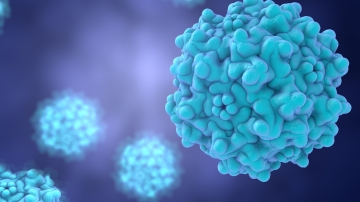Viral vector vaccines vs. mRNA vaccines: The differences
Table of contents
ShowVaccines are vital in the fight against infectious disease and for protecting public health. Two prominent vaccine technologies that have emerged are viral vector vaccines and mRNA vaccines. These innovative technologies hold significant potential for further advancements.
In this article, we will discover the mechanism of vaccines based on viral vectors and non-viral-vector-based mRNA vaccines, highlighting both differences and similarities of these two approaches and framing them in the context of other common vaccine types.
Common vaccine types
Several types of vaccines are currently in use to decrease the danger that infectious diseases pose to public health. They have gained an increase in attention with the emergence of the Coronavirus disease 2019, when the global effort in vaccine development resulted in innovative mRNA COVID-19 vaccines receiving emergency use authorization.
However, this is just one vaccine technology. There are several other ways that have been successful in combatting dangerous pathogens. Here is a list of common vaccine types:
- Inactivated vaccines
These vaccines use pathogens that have been rendered non-infectious that are then recognized as foreign and cause an immune response. - Live-attenuated vaccines
These vaccines use weakened forms of the pathogen to induce immunity without causing illness. - Subunit vaccines
Targeting specific components of a pathogen, subunit vaccines are known for their safety and efficacy. - Toxoid vaccines
Toxoid vaccines focus on neutralizing the toxins produced by certain bacteria. - mRNA vaccines
A breakthrough technology, mRNA vaccines instruct cells to produce a harmless piece of the target pathogen, triggering an immune response. - Viral vector vaccines
These vaccines utilize harmless viruses as carriers to introduce information from another pathogen’s genome, promoting an immune response.
Source:1
Mechanism of action of viral vector vaccines
Viral vector vaccines represent an innovative approach to immunization, using harmless viruses to deliver genetic material. They hold promise not only for COVID-19, exemplified by the AstraZeneca vaccine, but also for other infectious diseases like Ebola and Zika.
Here’s a brief overview of how viral vector vaccines are produced and the way they interact with the immune system of vaccine recipients:
- Selecting the viral vector: Scientists choose a virus (with AAVs being the by far most frequently used viral vectors in gene therapies2) as the delivery vehicle. This virus cannot cause the target disease.
- Genetic engineering: DNA from the target pathogen, such as the SARS-CoV-2 spike protein, is inserted into the viral vector.
- Cell entry and expression: The viral vector, now carrying the genetic instructions for a piece of the target pathogen, is administered as a vaccine. It enters human cells, where these instructions are utilized to produce the harmless target protein.
- Immune response: The immune system recognizes this spike protein as foreign and generates an immune response. Antibodies and immune cells are primed to combat the protein if encountered again.
- Memory response: Importantly, the immune system retains a "memory" of this encounter, enabling it to swiftly respond should the individual be exposed to the actual pathogen in the future.
Source:2

How mRNA vaccines based on non-viral vectors work
mRNA vaccines are some of the most innovative vaccine types. They have gained broader attention due to their application against COVID-19, but their potential is far from being restricted to a single application. For instance, Moderna is currently working on mRNA vaccines for diseases like influenza or RSV.3
Here's a straightforward breakdown of their mechanism of action:
- Messenger RNA (mRNA) introduction: mRNA vaccines contain genetic instructions in the form of mRNA. Covered by non-viral vectors like LNPs, this mRNA carries the blueprint for producing a specific antigen, often a harmless fragment of the virus, such as the spike protein of SARS-CoV-2.
- Cellular uptake: When administered, the mRNA is taken up by cells at the injection site.
- Antigen production: Inside these cells, the mRNA serves as a template for the production of the target antigen.
- Immune response: The immune system identifies this antigen as foreign and mounts a robust immune response. This includes the production of antibodies and activation of immune cells.
- Memory response: Importantly, the immune system retains a "memory" of this encounter. This ensures a swift and effective response if the individual encounters the actual pathogen in the future.
Source:3
Viral vector vs. mRNA
Differences between viral vector vaccines & mRNA vaccines
Both viral vector vaccines and mRNA vaccines based on non-viral vectors (such as lipid nanoparticles) rely on the delivery of genetic material with the goal to be synthesized in vivo. However, there are two major differences in their construction.
Firstly, viral vector vaccines, as their name already suggests, are based on viruses as natural vector system. These vaccines use the ability of harmless viruses to enter cells and hijack them, causing them to make proteins based on their genetic blueprint.
mRNA vaccines based on non-viral vectors need another carrier for gene delivery, such as lipid nanoparticles. These LNPs are able to encapsulate the genetic material they are supposed to deliver to specific target cells.
Another aspect by which non-viral-vector-based mRNA vaccines and viral vector vaccines differ is the type of genetic material they carry: Unlike mRNA vaccines, viral vector-based vaccines do not deliver mRNA, but DNA to target cells.4
Novel vaccine types and their fields of application
Both viral vector vaccines and non-viral-vector based mRNA vaccines are promising vaccine types, with many examples already on the market or currently being investigated on.
General progress is related to the development of COVID-19 vaccines, with three vaccine types in the spotlight:
- mRNA vaccines, exemplified by Pfizer-BioNTech and Moderna vaccines, introduce messenger RNA (mRNA) that encodes a harmless piece of the virus into the body. The immune system responds by producing antibodies against the antigen.
- Viral vector vaccines, as demonstrated by the Janssen/Johnson & Johnson or the Oxford AstraZeneca vaccine, use harmless viruses as delivery vehicles to introduce genetic material from the virus into the body. This genetic material may include the blueprint for producing a viral protein, prompting an immune response.
- Protein subunit vaccines, such as Novavax's COVID-19 vaccine, focus on delivering a piece of the virus, often a protein or protein fragment, to trigger an immune response.
They all had to undergo strict validation processes by regulators like the FDA. Clinical trials had to be conducted to monitor side effects and adverse event as well as to determine the necessary number of doses of the vaccine, the optimal timespan between the first dose, the second dose and possibly a booster dose, along with many other factors.5
But, as already stated, these novel vaccine types hold promise for many other applications. For instance, there are mRNA vaccine candidates in by Moderna in clinical phase 3 for influenza, RSV and cytomegalovirus (CMV), and mRNA vaccines against HIV are being studied as well.6
Read more: Novel methods in vaccine manufacturing
Besides being used in a therapeutic setting, mRNA is also believed to be key to cancer vaccines: Several mRNA vaccines have been studied for effectiveness against melanoma or pancreatic cancer.7
Despite many mRNA vaccine candidates are still far away from admission, the manifold fields of research illustrate the high hopes that the health care sector puts in this class of vaccines.
5 6 7

Challenging cold chain management – similarity between viral vector and mRNA vaccines
Cryopreservation poses a significant challenge in the distribution of both viral vector and mRNA vaccines based on non-viral vectors. Ensuring the stability and efficacy of these vaccines during transportation and distribution requires strict temperature control.
Therefore, regulatory authorities like the U.S. Food and Drug Administration (FDA) are concerned with the optimal storage and transport conditions for viral vector vaccines and mRNA vaccines. It is important to adhere to strict protocols in order to maintain the quality and safety of these valuable biopharmaceuticals in the fight against severe diseases.
Read more: Challenges in viral vector production or Viral vector manufacturing solutions
Today, single-use systems can provide a number of advantages to vaccine development, manufacturing and distribution. This is also true for single-use-based cold chain solutions, where fast and controlled freezing processes are indispensable and exceed what can be achieved by a conventional household freezer by far.
Single Use Support has established a product line-up that is able to streamline the entire vaccine production process, particularly focusing on cGMP-compliant fluid and cold chain management. The automated fluid management platform RoSS.FILL is able to aliquot large amounts of biopharmaceuticals into primary packagings with enormous precision. With a reduced need for manual intervention, human errors as well as the risk of contamination and exposure can be minimized.
RoSS.pFTU is a freezing platform based on plate freezing technology. It can freeze in a fast and controlled manner to -80 °C. The controlled-rate freezing helps to avoid damaging effects associated with insufficient freezing processes, such as cryoconcentration.
With innovative solutions based on single-use technologies, Single Use Support can facilitate fluid and cold chain management of both mRNA and viral vector vaccines, supporting them on their mission to make severe diseases more manageable.
- Vaccine Types, https://www.hhs.gov/immunization/basics/types/index.html, Published
- 3 Trends In Lentivirus Development And Manufacturing, https://www.cellandgene.com/doc/trends-in-lentivirus-development-and-manufacturing-0001, Published 2022
- Research, https://www.modernatx.com/research/product-pipeline, Published
- Viral Vector COVID-19 Vaccines: 4 Things to Know, https://www.houstonmethodist.org/blog/articles/2021/mar/viral-vector-covid-19-vaccines-4-things-to-know/, Published 2021
- Types of COVID-19 vaccines: How they work, https://www.mayoclinic.org/diseases-conditions/coronavirus/in-depth/different-types-of-covid-19-vaccines/art-20506465, Published
- Research, https://www.modernatx.com/research/product-pipeline, Published
- Can mRNA Vaccines Help Treat Cancer?, https://www.cancer.gov/news-events/cancer-currents-blog/2022/mrna-vaccines-to-treat-cancer, Published 2022











